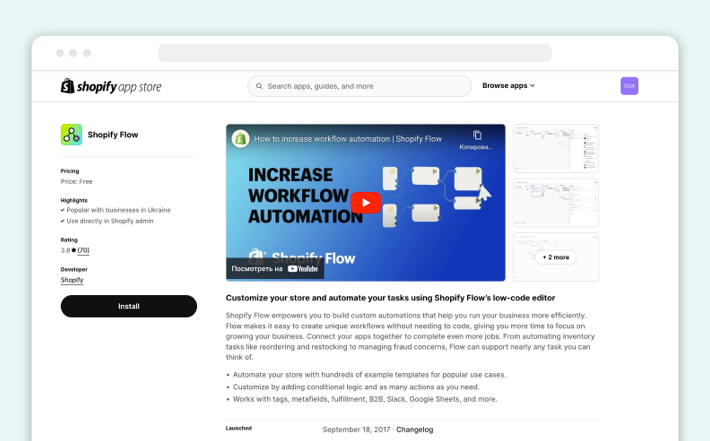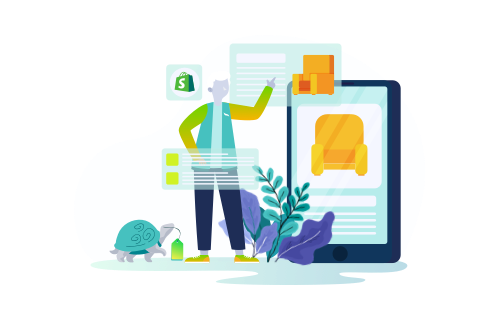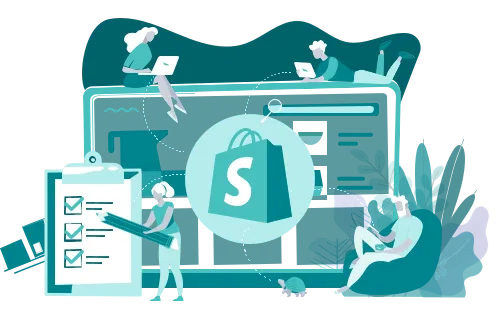Feeling like a one-person order fulfillment, inventory control, and customer service center? We hear you. Shopify store automation deals with that never-ending to-do list, letting you focus on growing your business.
It helps you streamline repetitive tasks — think sending abandoned cart reminders or providing upselling offers — and free your time for critical operations. It goes beyond mere convenience, ensuring you don’t miss out on significant revenue.
In this article, we’ll discuss Shopify automation in depth. We’ll explore its benefits, explain how to set it up, and provide tips for a smooth transition. Having done this for over 200 clients, including Winky Lux and Kit & Kin, we’re ready to share practical automation insights with you.

Benefits of Shopify Store Automation
Marketing, inventory management, order fulfillment, customer support, and other common workflows may no longer be your concern with automation. Let’s take a closer at these very benefits of automating your Shopify store:
Reduce Manual Work with Shopify Flow
Shopify Plus Flow is a built-in automation tool that lets you create custom workflows to automate repetitive tasks and reduce human error. Think of automatically triggering low inventory email notifications, sending abandoned cart reminders, or tagging customers based on their purchase history — all without lifting a finger. Flow makes it possible for you.
Want to automate your store with Shopify Flow? Get a quick consultation with our experts!
Leverage Tagging for Greater Convenience
Tagging allows you to categorize your customers, orders, products, and beyond to quickly find the necessary information from your Shopify admin. Besides simple tags, you can segment customers based on their actions, purchase history, and demographics to personalize marketing campaigns and deliver targeted offers.
Collect and Analyze Data Effectively
Shopify automation does more than just streamline workflows. It helps you understand your customers’ behavior better and use these insights to personalize their experiences. It also lets you forecast inventory needs, improve your marketing strategy, and make smarter choices when adding new products or services.
Integrate Your Entire Shopify App Ecosystem
If you use multiple Shopify apps and APIs to manage different aspects of your store, automation makes it easy to integrate them all. Just connect workflows within these applications, automate data transfer, and create a unified ecosystem that works for you.
Scale Faster
The more your store expands, the harder it becomes to manage everything manually. Automation, in turn, helps you scale quickly since all mundane tasks have been handled for you. Besides that, you don’t even need to hire more workers, as automation takes care of most day-to-day operations.
How to Automate Your Shopify Store in 2024?
If you’re ready to reap the above advantages and streamline your operations, keep reading. We’ll tell you how to automate Shopify store in several steps.
Identify Repetitive Tasks
The key to successful Shopify store automation is specifying repetitive tasks that can actually be automated. Here are some common ones:
- Order processing. Sending confirmation emails, updating inventory levels after a sale, and even delivering orders to fulfillment centers are just several processes you can perform automatically.
- Inventory management. Streamline inventory control by automating product listing updates with real-time stock levels. Set triggers to automatically adjust prices or notify you when stock is running low.
- Customer communication. Automate email and SMS notifications for order statuses, abandoned cart reminders, and product restocks.
- Customer support. Leverage chatbots to answer common questions or help customers with various issues they may face 24/7.
- Marketing. Automate email marketing campaigns by segmenting and tagging your customers.
Choose the Right Automation Tools
Shopify Flow is a perfect built-in automation tool for creating custom workflows in your Shopify store. It covers most of the tasks we listed above.

Yet, if, for some reason, you want to try other automation solutions, consider the following:
- Marketing automation. Use Klaviyo, MailChimp, Omnisend, or HubSpot. Our clients prefer Klaviyo for automated sequences in their email strategies.
- Built-in Shopify apps. Leverage Shopify Flow mentioned before, Shopify Scripts (for Plus merchants only), or Launchpad for automation of various processes.
- Third-party apps. Consider apps like Rebuy for upselling and cross-selling, Zapier for overall store automation, or Auto Fulfill for Shopify automatic order fulfillment.
Automate Shopify Store Step-by-Step
Once you’ve done all preparations, move on to automating your store. The process typically takes the following steps:
- Determine your automation goals. Choose repetitive tasks from the list above or identify any other areas that could benefit from automation.
- Define the automation workflow. Map out the steps of the task you want to automate.
- Choose an automation tool. Select the best software for the task you aim to automate. We suggest Shopify Flow as the most versatile solution.
- Set up the workflow in the app. Follow the app’s instructions to customize triggers, actions, and conditions for your automation.
- Launch the workflow. Once everything is set up, activate your workflow and watch it work.
Tips for Effective Shopify Automation
Besides learning the core automation steps, you should implement all workflows with precision. If you need help with this, talk to our experts. Alternatively, leverage the following Shopify store automation tips:
- Personalization with smart on-site product suggestions. You can hardly keep track of all your customers’ preferences manually. That’s why it’s best to use automation tools to recommend relevant products following a customer's browsing history or previous purchases.
- 24/7 support with a human touch. Provide real-time customer support with AI chatbots. These tools can answer frequently asked questions, help customers solve their issues, and even collect valuable customer data — all outside of business hours.
- Retarget abandoned carts. Use automatic email and SMS notifications to nudge customers who have left items behind. Leverage messages that encourage them to complete their purchases.
- Automated communication. Go beyond basic order confirmations. Use email and SMS automation for invoicing, in-stock updates, upselling, and cross-selling. For example, send automated emails with product recommendations based on the customer's cart contents.
- Engage after the first purchase. Turn first-time buyers into your loyal customers with targeted automation. Send push notifications after a customer’s second order to welcome them back and offer loyalty program incentives.
- Fast issue resolution. Use automation to create support tickets automatically after receiving a negative review. That’s how you can address customer concerns promptly and show that you really care about their shopping experience.
- Segmentation for precise marketing. Other tips for automating your Shopify store include segmenting customers based on their purchase behavior. That’s the way to personalize your marketing messages for different customer groups.
- Dynamic pricing to stay competitive. Leverage data-backed and dynamic Shopify price automation software. Such tools let you set pricing rules based on real-time market conditions, competitor pricing, and inventory levels to ensure you always put the right price tags on your products.
GenovaWebArt as Your Shopify Automation Partner
GenovaWebArt has been helping e-commerce businesses thrive since 2012. Shopify Flow is always our top consideration when designing solutions for our clients. This tool is indeed an efficient way to streamline processes without complex coding.
Our team of Shopify experts can help you:
- Identify the most impactful tasks to automate in your store.
- Design and implement custom workflows using Shopify Flow.
- Integrate other Shopify apps (Klaviyo, for example) for seamless automation.
- Analyze the performance of your automated workflows.
- Continuously improve your automation strategy for prolonged success.
Over 200 clients have trusted us to optimize their stores through Shopify automation, design, and development. Here are just two prominent examples:
Winky Lux

Winky Lux, a beauty brand from New York, approached us with a multi-faceted project. They wanted to:
- Implement new features to improve customer experience.
- Expand their promotional strategies with more discount options.
- Get deeper customer insights through a custom statistics collection app.
We knew combining Shopify’s tools and our development expertise was key to success. As a solution, we leveraged Shopify Scripts to build custom features and Shopify Flow to automate everyday tasks. Our specialists integrated Winky Lux with Klaviyo to achieve advanced customer segmentation and targeted marketing campaigns.
Kit and Kin

Kit & Kin, a leading UK-based baby care brand, struggled with WooCommerce limitations. They needed a robust e-commerce platform to streamline order fulfillment, subscriptions, and customer management.
Shopify Plus, with its scalability and advanced features, was the perfect fit. Here’s how we transformed their business:
- We migrated Kit & Kin from WooCommerce to Shopify Plus, ensuring minimum disruption.
- Our experts integrated their store with Klaviyo for custom sales analytics and customer base segmentation.
- Our team used Shopify Flow to automate workflows for order fulfillment, subscription management, and other daily operations.
- Improving their customer experience even more, we leveraged Shopify Scripts to develop custom features.
Want to see more examples of how we automate processes for Shopify businesses? Explore our portfolio.
Conclusion
Having learned how to automate your Shopify store, you no longer need to be frustrated by the mundane tasks on your to-do list. With most of the processes handled automatically, you can finally focus on what matters the most — your business growth.
From streamlined marketing and optimized inventory to fulfilled orders and happy customers, that’s what Shopify automation offers. Don’t forget to use Shopify Flow along the way, as this tool provides comprehensive automation on its own.
And if you need someone to help you streamline your store’s processes, count on GenovaWebArt experts. We know what it takes to automate Shopify successfully and are eager to assist you. Just drop us a line with your requirements and wait till we get back to you.
Frequently Asked Questions
How can automation increase sales in my Shopify store?
- It frees your and your team’s time, so that you can dedicate more effort to strategic tasks like product development.
- It helps you personalize the shopping experience, which brings happier customers and ultimately, higher sales.
- It reduces human error and manual work, which leads to cost savings.
Can automation help reduce cart abandonment rates?
How do I measure the impact of automation on my sales?
- Conversion rate. Track if automation has influenced the number of users completing purchases on your store.
- Average order value. See if automation impacts the average amount customers spend per order.
- Customer lifetime value. Measure the total revenue you get from a customer throughout their relationship with your brand.
- Abandoned cart rate. Check how automation of abandoned cart reminder emails affects the rate at which customers abandon their carts.
What are some examples of Shopify automation workflows?
Here are several examples of Shopify automation workflows you can implement:
- Welcome email. New customer signs up — send a welcome email with a discount code.
- Order confirmation. When the order is placed, send an automated confirmation email with tracking info.
- Abandoned cart reminder. When a customer abandons their cart, you can automatically email them the items from their cart.
- Inventory management. Product stock reaches a low level — trigger a notification for restocking.
- Upsell. When a customer completes a purchase, send an email with recommendations for complementary products.
How do I implement Shopify store automation?
To automate Shopify store, it’s best to take the following steps:
- Identify day-to-day tasks you want to automate.
- Select a suitable automation tool from the built-in Shopify solutions or third-party vendors.
- Plan the stages of the automation workflow.
- Create the workflow in the automation app.
- Activate the workflow and monitor its performance.
- Refine the workflow if necessary.



